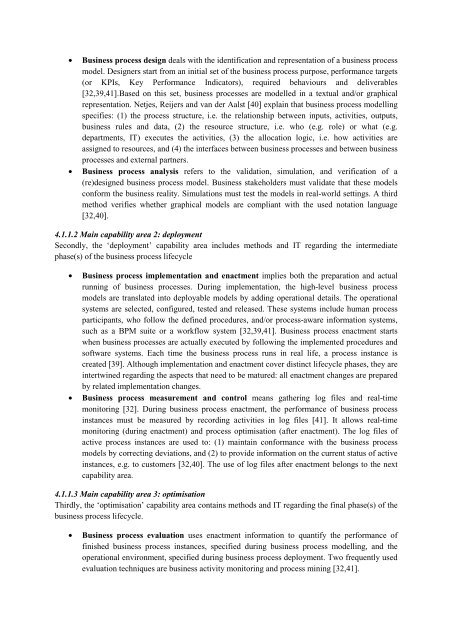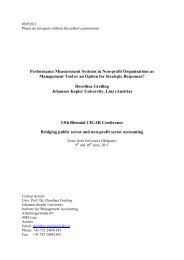A theoretical framework and classification of capability areas
A theoretical framework and classification of capability areas
A theoretical framework and classification of capability areas
You also want an ePaper? Increase the reach of your titles
YUMPU automatically turns print PDFs into web optimized ePapers that Google loves.
• Business process design deals with the identification <strong>and</strong> representation <strong>of</strong> a business process<br />
model. Designers start from an initial set <strong>of</strong> the business process purpose, performance targets<br />
(or KPIs, Key Performance Indicators), required behaviours <strong>and</strong> deliverables<br />
[32,39,41].Based on this set, business processes are modelled in a textual <strong>and</strong>/or graphical<br />
representation. Netjes, Reijers <strong>and</strong> van der Aalst [40] explain that business process modelling<br />
specifies: (1) the process structure, i.e. the relationship between inputs, activities, outputs,<br />
business rules <strong>and</strong> data, (2) the resource structure, i.e. who (e.g. role) or what (e.g.<br />
departments, IT) executes the activities, (3) the allocation logic, i.e. how activities are<br />
assigned to resources, <strong>and</strong> (4) the interfaces between business processes <strong>and</strong> between business<br />
processes <strong>and</strong> external partners.<br />
• Business process analysis refers to the validation, simulation, <strong>and</strong> verification <strong>of</strong> a<br />
(re)designed business process model. Business stakeholders must validate that these models<br />
conform the business reality. Simulations must test the models in real-world settings. A third<br />
method verifies whether graphical models are compliant with the used notation language<br />
[32,40].<br />
4.1.1.2 Main <strong>capability</strong> area 2: deployment<br />
Secondly, the ‘deployment’ <strong>capability</strong> area includes methods <strong>and</strong> IT regarding the intermediate<br />
phase(s) <strong>of</strong> the business process lifecycle<br />
• Business process implementation <strong>and</strong> enactment implies both the preparation <strong>and</strong> actual<br />
running <strong>of</strong> business processes. During implementation, the high-level business process<br />
models are translated into deployable models by adding operational details. The operational<br />
systems are selected, configured, tested <strong>and</strong> released. These systems include human process<br />
participants, who follow the defined procedures, <strong>and</strong>/or process-aware information systems,<br />
such as a BPM suite or a workflow system [32,39,41]. Business process enactment starts<br />
when business processes are actually executed by following the implemented procedures <strong>and</strong><br />
s<strong>of</strong>tware systems. Each time the business process runs in real life, a process instance is<br />
created [39]. Although implementation <strong>and</strong> enactment cover distinct lifecycle phases, they are<br />
intertwined regarding the aspects that need to be matured: all enactment changes are prepared<br />
by related implementation changes.<br />
• Business process measurement <strong>and</strong> control means gathering log files <strong>and</strong> real-time<br />
monitoring [32]. During business process enactment, the performance <strong>of</strong> business process<br />
instances must be measured by recording activities in log files [41]. It allows real-time<br />
monitoring (during enactment) <strong>and</strong> process optimisation (after enactment). The log files <strong>of</strong><br />
active process instances are used to: (1) maintain conformance with the business process<br />
models by correcting deviations, <strong>and</strong> (2) to provide information on the current status <strong>of</strong> active<br />
instances, e.g. to customers [32,40]. The use <strong>of</strong> log files after enactment belongs to the next<br />
<strong>capability</strong> area.<br />
4.1.1.3 Main <strong>capability</strong> area 3: optimisation<br />
Thirdly, the ‘optimisation’ <strong>capability</strong> area contains methods <strong>and</strong> IT regarding the final phase(s) <strong>of</strong> the<br />
business process lifecycle.<br />
• Business process evaluation uses enactment information to quantify the performance <strong>of</strong><br />
finished business process instances, specified during business process modelling, <strong>and</strong> the<br />
operational environment, specified during business process deployment. Two frequently used<br />
evaluation techniques are business activity monitoring <strong>and</strong> process mining [32,41].

















